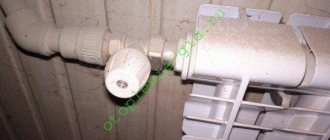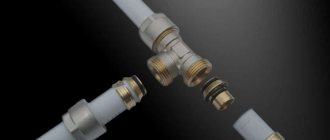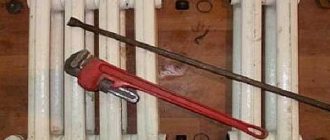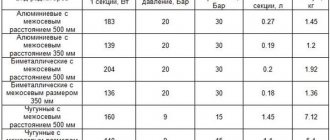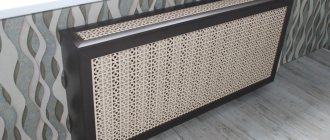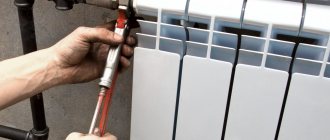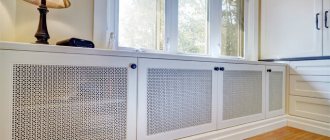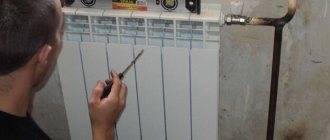The reason why disassembling and assembling aluminum sections becomes a necessity does not always arise spontaneously.
The most unpleasant reason forces the owner to involve a qualified specialist in urgent repairs of his heating equipment.
The appearance of a crack, an obvious leak or fogging of a weakened rib directly on the section itself leads to the idea of its inevitable replacement. Another reason is to increase or decrease the number of radiator sections to change the heat transfer coefficient.
Tool to help
A basic set of tools that you can’t do without:
- radiator, nipple key;
- open-end wrenches;
- mount;
- grinder for trimming operations;
- a set of paronite gaskets and plugs ;
- adjustable, plumbing, key;
- construction hair dryer;
- gas key No. 2.
The role of the main tool in the upcoming work is assigned to the nipple wrench.
The wrench is a thick-walled pipe with notches along its length and a flat tip with a spatula . a round metal rod, flattened at one end . The tool is calibrated by a series of notches, the spacing between which corresponds to the width of one section.
An adjustable or open-end wrench is required to carefully loosen galvanized couplings and enamel-coated end caps. A pry bar, grinder and hair dryer may be needed if problems arise with dismantling stuck joints.
Installation of ball valves on batteries
A conventional ball valve is designed only to switch to 2 positions: “open” and “closed”. It cannot be used to regulate the flow of coolant through the radiator, only shut it off. The figure below shows a simple connection diagram for a heating device with this type of fittings:
The proposed scheme is the best option for an unregulated connection of a radiator to the central heating risers in an apartment. You won’t have to balance it anyway, and installing a thermostatic valve is pointless due to the poor quality of the coolant. Instead of a ball valve at the outlet, it is also practiced to install a so-called shut-off valve; its difference is only in appearance.
Depending on the layout of appliances and heating pipes, you can choose an angle valve for a radiator with or without a decorative coating. Also, when choosing a product, it is recommended to pay attention to the operating pressure indicated on the product body or in its passport. It must correspond to the pressure in the heating network of the apartment building.
Advice. For installation on the radiator, choose good taps made of thick-walled brass and a connection with an American union nut. It will allow you to quickly disconnect the connections without rotating the elements. On a single-pipe riser, do not forget to install the bypass with a slight offset away from the main pipe.
Do-it-yourself disassembly and assembly of an aluminum radiator
The area where the radiator restoration will be carried out is covered with thick fabric . If this is a table surface, then the main work will not take place in weight. The prepared area will protect the soft aluminum from receiving unnecessary deformations and scratches.
Important ! Before removing the union couplings, a rag is spread under the radiator to protect the floor from dirty liquid that may leak out during dismantling. You need to have a rag on hand to absorb any remaining moisture remaining inside the sections.
Disconnection from the heating network
Before starting disassembly, the radiator is disconnected from the heating network using shut-off valves . If there are no shut-off valves at the radiator, then a housing and communal services worker is invited to turn off the heating riser for repair work.
During the heating season, after shutting off the radiator, they take a break. Since the water in it is still hot, wait for a while until the liquid cools down , and then disconnect the radiator from the heating pipes.
The coolant remaining in the battery is poured into a previously prepared bucket and the sections begin to be separated. Immediately after dismantling, the inner surface of the battery is washed with running water.
How to disassemble and reassemble the battery
Aluminum sections connected by nipple nuts . The inner part of such a connector has protrusions by which the nipple wrench grabs the nut and unscrews it. A nut is similar to a coupling, only it has an external thread . One nipple nut has both right-hand and left-hand threads. They are made in pairs for the top and bottom connections. When the nipple is untwisted, the sections move apart, and when twisted, they are pulled together.
All plugs and adapters are pre . The connector must be accessible from all sides by the nipple wrench.
Photo 1. Fastening sections of an aluminum radiator to each other: the nipple nuts unscrew when disconnected.
To disassemble the battery, place the tool blade through the open end of the radiator into the grooves of the unscrewed upper nipple nut and, with some pressure, make a test roll counterclockwise to move the connection. If the key turns the nut normally, then insert it into the grooves of the lower nipple nut and, as in the first case, try to turn it a couple of turns.
Important ! When unscrewing connectors, follow the sequence of actions to avoid distortion.
After disconnection, the exposed thread is carefully examined for cracks and chips , and for the integrity of the thread . If necessary, the joints are cleaned with fine emery cloth.
When assembling the radiator sections, paronite O-rings are placed and placed between the sections. I lightly press the sections together and screw them together alternately. Turning the nuts to prevent distortion is limited to two turns of the wrench .
If something went wrong
During operation, the joints between sections and steel nuts stick to each other . This comes from the quality of the coolant supplied to the heating system. Sometimes even significant physical efforts are useless.
Although sticking must be dealt with, aluminum warps easily because it is a soft metal.
By heating the joints with a construction hairdryer, you can overcome stuck rust . If this doesn’t help either, because the corrosive build-up is too corrosive, then the edger gets to work.
Advice. If the nipple nut does not turn off under great pressure, then there is no need to increase the applied force with excessive leverage . In the worst case scenario, not only will the nut itself break, but both sections that sit tightly on the nut will crack.
section is cut off with a grinder , from the reverse side and at a distance from the edge of the joint by no less than half the length of the coupling. This protects the working section from destruction and does not cut the connecting nut. During cutting, the rust bounces off, making it easier to unscrew the surviving section.
During assembly, it is advisable to replace old gaskets with new ones and clean the joints , paying attention to defects and irregularities. A tight connection protects against premature leaks .
Why are there taps on radiators?
Each heating device is a separate element of the system that requires adjustment and periodic maintenance. If you control the coolant flow through the batteries depending on the heat demand, you can achieve good results in terms of energy savings. That is, radiator valves and heating taps are designed to solve the following problems:
- Complete isolation of the heating device from the system.
- Restriction of coolant flow through the battery.
- Change in coolant flow depending on external conditions.
- Bleeding air from the radiator and piping network.
There are many situations in which it is difficult to do without disconnecting the battery. For example, properly working central heating in the middle of spring, when it’s already warm outside, but it’s just hot in the apartment. Another case is the need to remove a heating device for the purpose of replacement, flushing or repair. In the absence of shut-off valves, carrying out any action with the radiator becomes problematic.
Dismantling cast iron radiators
To dismantle cast iron heating radiators, the following set of tools is required:
- Pipe wrench number 3 (needed to unscrew the locknut and fitting);
- Pipe cutter or grinder;
- Hacksaw for metal;
- Chisel;
- Hammer and sledgehammer;
- Brush.
It is best to dismantle cast iron radiators (and any other heating devices) in the summer, when the heating system is turned off. Before disassembling the cast iron heating radiator into sections, it is necessary to drain all the coolant from the heating circuit.
The first step is to unscrew the locknuts that are located on the connections to the radiators. Next, the flaps are turned away, and the radiator can be removed. If it is not possible to unscrew the locknuts, then the connections are simply cut off, after which the radiator can be easily removed from the supports.
Useful video
How to assemble an aluminum heating radiator - video:
The need to disassemble heating radiators may arise in every home. If one of the sections leaks, it needs to be replaced or removed. It is necessary to add additional fins when the existing ones do not warm the room to the required temperature. And if during the heating season the apartment becomes hot, you need to remove the extra sections. Such problems can be solved with the help of professionals, but if your financial condition leaves much to be desired, you will have to learn how to disassemble a heating radiator with your own hands. This will allow you to save money and gain useful experience.
How to disassemble a heating radiator with your own hands
How to disassemble a cast iron heating radiator into sections
Before disassembling a cast iron heating radiator, you need to prepare a set of tools:
- Wrench for disassembling cast iron batteries (5/4 inches for old devices and inch for new ones);
- Adjustable wrench of the second or third number;
- Chalk;
- Inch pipe 50-100 cm long.
You also need to find a convenient platform on which to disassemble the radiator. A good option would be a durable wooden board placed on a flat area. The battery is placed horizontally on this shield, and disassembly can begin.
The technology for disassembling the radiator is as follows:
- First of all, you need to understand in which direction the blind plugs are unscrewed, after which they need to be unscrewed. Before disassembling the heating battery, it is necessary to mark on the key the length to the unscrewed nipple. To do this, the key is placed on the battery and its edge is brought to the point where the bushing is located. A mark is made on the key using chalk in a circle until the key is inserted into the battery.
- Next, you need to figure out in which direction the key for cast iron batteries should rotate - they can have both left- and right-hand threads. Accordingly, when rotating in different directions, the battery sections will diverge or converge. The direction of rotation is determined using a fitting, which is screwed in on the same side where the key will subsequently be inserted.
- With a right-hand thread, the fitting is screwed in clockwise, so the direction of rotation of the key when unwinding will be the opposite. With a left-hand thread the situation is exactly the opposite.
- The actual promotion of the radiator begins with the first section. The first step is to strip the threads on both nipples one by one (as a rule, just half a turn of the key is enough). Next, the battery is gradually untwisted on each side so that the distance between the sections is about 0.5 cm.
- When unwinding, it is very important to maintain the specified gap between the sections - if you untwist the battery on one side more strongly, then there is a considerable probability that the thread will jam. During the unwinding process, it is worth putting a pipe on the key to reduce the required effort.
Any modern radiator can be disassembled using this technology. Often, such heating devices have plugs with the thread direction marked.
Types of valves
Radiator taps for heating are divided into several types depending on the structure and principle of operation. They can be installed on radiators in private and apartment buildings, focusing on the type of specific batteries and the heating system as a whole. On sale you can find angle and straight valves with a ball or half-turn mechanism, made of brass, bronze or polypropylene with metal inserts. Experts most often use valves for balancing, devices for releasing air manually or automatically, as well as simple taps of a standard type.
Air
Air valves or Mayevsky taps are used to eliminate air from the heating system, which enters it with water and reduces heating efficiency. Since air usually accumulates at the top point, the valve is installed on top of the radiator. Such devices have low throughput, so they are usually mounted on modern radiators of the latest generation, made of steel or aluminum. Products of this type are easy to install and open using a screwdriver or special keys. The most convenient mechanisms are those that require a screwdriver.
A good air valve should be easy to turn counterclockwise because the air in the system needs to be vented periodically. The presence of air inside the pipes can be determined by a characteristic hissing sound. When it stops, the tap is closed. When connecting the pump, be sure to turn it off before bleeding the air.
Angular
The corner valve for radiators is of the balancing type. It closes and opens with one turn, moving a few millimeters, which makes it easy to fix it in the desired position.
An angle-type shut-off valve is installed at the outlet of the radiator, suitable for two-pipe and single-pipe heating systems. Made taking into account the design features of standard radiators and helps to carry out various operations during installation and repair work. When installing such cranes, it is imperative to use American valves and other necessary tools.
With adjustment
Adjustable valves help control the flow of water and change the temperature in the room, maintaining it at the optimal level. The thermostatic valve is a simple siphon, inside of which there is a container with gas or liquid. When the temperature rises, the gas or liquid begins to expand and puts pressure on the rod. Then it lowers and blocks the access of water inside the radiator. As the temperature decreases, the rod will begin to rise, which will provoke an increase in the flow of water in the battery. Gas-type models respond to temperature changes faster, and they do not differ much in cost from standard water valves.
Ball
The ball-type radiator valve received this name due to its mechanism, which is a small ball with a hole. The valve can be in two positions: closed and open. When the device is rotated 90 degrees, the heat supply through the pipes stops. Ball valves are considered the most popular and are made from various materials, most often brass, bronze, steel or polypropylene. They have an angular or straight design, differ in throughput - it can be standard or semi-through. To increase operating efficiency, semi-bore control valves are selected and mounted on radiators using a nut or an American nut.
Dismantling an old radiator
In the case of old batteries, some problems may arise - for example, the threads in such devices may become stuck, so before disassembling they will need to be heated with a blowtorch or autogen. When the joints are heated, you need to quickly tear off the nipples on both sides of the battery. Using the same method, any elements stuck to the battery are removed.
After prolonged use of the battery, the nipple may completely rust. In this case, it will be impossible to hook it with a key, so to disassemble the battery you will need a hacksaw or grinder. The remains of the nipples are unscrewed from their places, and the threads are cleaned with a brush.
If none of the described methods helps, the last resort option is to smash the battery with a sledgehammer. Before breaking a cast iron battery, it must be placed on a horizontal surface and hit along the center line with a sledgehammer until part of the section falls off. After this, the battery must be turned over and the operation repeated to break the entire section.
All that remains is to place the radiator vertically, apply several blows to the surviving sections and untwist them. Of course, in this case there is no need to talk about the integrity of the entire radiator - in most cases, half of the sections are lost.
Radiator tap function
Most modern radiators are able to perform their basic functions without the use of additional elements. But there are situations in which a radiator tap for heating is simply irreplaceable. This happens when you need to install, remove or replace the battery, check its performance, test it after installation, or carry out other work. The control mixer helps to partially shut off the heat supply during flushing or preventive diagnostics of various system elements. This allows you to significantly reduce the time spent on repair work, since you will not need to completely drain the water in the entire heating system.
The faucet also makes it possible to stop the battery in one room if that room does not need to be heated for a certain period. Using the device, you can regulate the heat supply automatically or manually, remove air pockets from the batteries, due to which the system will not function normally. Standard and ball valves for heating are necessary to regulate the temperature in the room. For example, if the heating in the central system has not yet been turned off in the spring, it will be impossible to change the temperature of the radiator without the help of a valve.
Disassembling an aluminum and bimetallic radiator
Before disassembling the heating battery, prepare the necessary tools.
The main tool is a nipple wrench (can be rented at a specialized store for little money). It is a rod about 700 mm long. On one side, a key head with a size of 24x40 mm is welded to it, and on the other, a through hole is made. You can insert a metal rod into it. It will make it easier to turn the nut.
This is the main tool used when assembling/disassembling heating radiators
There are several notches on the surface of the key. The distance between them corresponds to the width of the radiator section. By inserting the key inside the battery and counting the number of notches, you can easily find the nipple for the desired section.
Before disassembling the heating battery, you need to be aware of the direction of rotation of the key. Place the radiator on a flat horizontal surface with the front side up. On the right there will be a right-hand thread, and on the left side there will be a left-hand thread. In order not to get confused, you can do it simpler: take the nut and tighten it alternately on the right and left, and then decide which way to turn the key. This is important because the threads can easily be stripped and then you need to buy two new sections. Imported manufacturers make the following designations for threads on the plugs and fittings on the front side of the section: D-right, S-left.
The thread on the nipple nut can be right-handed or left-handed, so before disassembling the radiator, we determine which direction to turn
Let's say you need to unscrew one section on the right. To do this, insert the key with a “spatula” into the upper hole to the desired location, secure it in the groove of the nipple nut and forcefully turn the key counterclockwise and “rip it off” from its place. This is where you may need a rod inserted into the ring on the key: a decent amount of force is required.
We make two full turns and move the key to the lower part of the radiator. We repeat the operation, rotating the key in the same direction. Unscrew the nipple 2 turns here too. We take out the key again and repeat the procedure for the upper part. So, one by one, unscrew the section completely. This is done to ensure that there are no distortions.
Heating radiator designs
If a heating element breaks down, especially in the cold season, it must be repaired or replaced immediately. Whether it is possible to disassemble the radiator depends on the type of its design. Quite often, non-removable types of radiators are installed in apartments, which cannot be restored. In this case, it is better to immediately purchase a new battery. But there are also collapsible models that can be dismantled to replace a damaged element and installed back.
Products are divided into two main types:
- Sectional batteries assembled from several identical sections reliably connected to each other. Each of them has a channel through which water circulates, and heat-emitting ribs warm the room. Sectional batteries are the most popular because the cost of such radiators is lower. If a breakdown occurs, it is enough to replace only the damaged section, and if necessary, you can always add or remove ribs.
Sectional heating radiators
- Monolithic products are one solid structure that does not have separate sections. In appearance, these radiators may resemble sectional counterparts, but the differences between them are obvious. Monolithic devices do not have connecting joints, due to which they are able to withstand greater pressure. Because of this, the trouble-free operation of these structures is almost twice as long as that of sectional ones. But in case of leakage, the monolithic device will have to be changed completely. In sectional products, it will be enough to replace the damaged element.
Bimetallic monolithic radiator
How to assemble an aluminum radiator
We assemble in reverse order. We place the sections on a flat surface (a suitable sized table or simply place it on the floor). If the radiator is not new, unscrew the end cap and Mayevsky tap.
Before installation, you should carefully examine the threads and grooves; they must be of high quality, without chips or changes. On the mounted section for testing, we “drive” the thread by screwing in and unscrewing the nipple. Here you need to pay attention to the fact that there may be a gasket under the layer of factory paint in front of the thread. Lightly rub the end with fine sandpaper; if it is found there, then it must be carefully cut off with a knife with a sharp blade.
This is what an aluminum radiator looks like in cross section
Before adding sections of the heating radiator, be sure to clean the ends to a smooth surface. We even remove factory paint. It is not needed at the ends of radiators, but will only contribute to the early appearance of leaks. Sooner or later, coolant will begin to seep under the paint. In the case of non-freezing liquids, this will happen very quickly; if water is used in the system, then not very much, but it will definitely happen. And then coolant will begin to leak between the sections, although the gaskets are still in perfect condition. The whole point is that the paint on the ends has peeled off or been corroded, and microcracks have appeared. So we make sure to clean the ends to bare metal, but use fine sandpaper so that the surface of the metal is smooth and without scratches. This guarantees the operation of the system without leaks in the radiators.
For better tightness, the ends then need to be degreased (using gasoline). Gaskets are also degreased, but they need to be washed with ordinary soapy water. For a system that will be filled with water, degreasing is an optional procedure, but for systems that will run on antifreeze it is necessary. Antifreezes have high fluidity and seep into the smallest pores. After everything is dry, we begin to assemble the aluminum radiators.
Then tighten both nipple nuts half a turn. Heat-resistant paronite (silicone) gaskets are placed on top of the nipple to seal the joints. Now we take the section that needs to be screwed and place it tightly against the nuts, checking the tightness of their fit. Next, insert the key into the upper hole and tighten it 1-2 turns. At the same time, we do not use the lever yet. We twist our hands. Then we perform the same operation in the lower hole. We repeat several times, alternately tightening both nuts several turns.
We unscrew the sections gradually, one or two turns of the nut, either from below or from above.
Tighten as much as you can. Only after tightening by hand can the lever be used. This must be done in two stages on each nipple. It is better not to use excessive force when final tightening the nipples, since you can easily break the threads: aluminum is a soft metal, don’t forget.
If the section is completely assembled, screw a plug onto the unused holes on one side, and a Mayevsky valve on the other (to bleed air from the system). Now you know how to assemble sections of a heating radiator and, if necessary, you can add several sections.
Radiator keys types and manufacturing features
The most complete information on the topic: “radiator keys, types and manufacturing features” with a full description and information from a professional master.
Name – Radiator key (25 mm) with handle and bushing Application – radiator keys are used for assembling and disassembling sections of bimetallic and aluminum heating radiators with a nipple with a diameter of 25 mm Country of origin – Russia Material – steel Radiator nipple size = 25 mm Key length – up to 7 sections Weight = 3 kg Certificate / passport (on request) Price (on request)
Dimensions
You can get advice , find out prices or fill out an application to buy this product by by e-mail to the address : proton . . ru or by calling in Moscow : + 7 (495) 641 16 85
| (click to play). |
Communities › DIY › Blog › Key for disassembling and assembling a heating radiator
It happened to add sections to an aluminum battery, I needed a key to the store, price 2500, I just sat down. A piece of rod with a blank.
same crap. I bought bushings for assembling batteries and realized that I needed to weld a key, so I’ll do it and give it to someone.
I also made a homemade one, only instead of a plate there was a milling sleeve, it turned out to be an ambush the first time, the rod turned out to be magmatic, I made the second one from a normal one, but what’s too much, they cost 500 rubles
I did exactly the same! it's been a long time already!
You can twist it with a regular flat mounting tool by clamping it with a gas wrench)
Usually it’s homemade, but I don’t think it was worth welding the nut, but access is limited, I think it’ll do, but spare the trash talk, rip it off with a wrench
Previously, I twisted cast iron ones homemade from scrap, but it also works great using a 6-sided nail puller and you don’t need to cook anything. Where are such prices 2500 interesting, in Leroy Merlin 790 for 10 sections, for fewer sections 500 rubles. approximately, both with bearings and rubber handles.
Thank you. Now I know what the key looks like. need to add sections...
and yes, I took risks in sections
Yes, in Leroy they are already 300
2500 rub. completely stunned! At the beginning of this year I bought it for 500 rubles.
Our region is equivalent to the far north, so the hucksters are going crazy.
Ciao, huckster, sorry. :)))
We welded the nut to the T-shaped fittings and tightened everything. Well done. It’s difficult for a welder in a private house now))
easy to do, very difficult!
heat the rod and flatten it as necessary. I made my own heating - I halved the radiators.
I also made the same thing. When the house defrosted. True, from a half-inch pipe and a piece of truck spring. Together with my dad, we sorted it out and started the heating in two days.
Well, there was a wood stove in the house.
As I understand it, for aluminum radiators, especially for old cast iron, it is rather weak.
heating with a technical hairdryer helps to defeat them)
Heating the hairdryer with gas turned out to be rather weak.
As I understand it, for aluminum radiators, especially for old cast iron, it is rather weak.
For cast iron it is too small; in cast iron the nipple is larger.
What is the width of the plate?
24 mm internal diameter of nipple 25 mm
Made from thick reinforcement. Flatten on one side while hot
cut and discard, will chamfer the nipple and rotate this plate. The end should be slightly smaller than the diameter of the nipple and the grooves should repeat the profile of the chamfers.
It won’t cut, I’ve already assembled the radiator, the plate fits in with minimal clearance, and on the factory key it also fits under the base of the tooth.
Having assembled one radiator, you have become a mega-specialist, and when you use this stick to disassemble a radiator that has been standing in the system for at least a year, we will return to the conversation
I disassembled and assembled aluminum radiators with a service life of 7 years; the nipples became rusty during operation, only at the edges they came off easily.
oh thank you now I know what the key looks like))) I need to do it otherwise the batteries are leaking
everything ingenious is extremely simple! 20 years ago, when I was installing heating at home, they made the same design...
these are now radiators in every store, and earlier during the day there was fire... so at the ferrous metal collection point we had to buy old cast iron radiators from the Soviet era (thawed out) cheaply, disassemble them into sections and assemble new live sections...
Dismantling cast iron radiators
The most common are cast iron radiators MC140. During their operation, which in some cases is 30 years or more, they have shown themselves only at their best:
- accumulates heat;
- resistant to poor quality coolant;
- ease of maintenance;
- reliable and have a long service life (from 10 years and above)
How to disassemble this grandfather? And it’s very simple, because structurally all radiators are assembled according to the same principle: using nipple nuts and gaskets for tightness. True, in those ancient times, tow with paint was screwed onto the nut and there was a rubber gasket.
Rules for the selection and installation of plugs
The simplest element used when installing and assembling radiators is an aluminum plug for heating radiators. But even the simplest device requires special attention, otherwise big problems may arise during operation.
The process of installing a radiator plug cannot be called complicated, since almost all of them are made of the same type; the dimensions or type of thread may be different. Such devices also work on the same principle.
Assembling a cast iron radiator
This is done in the reverse order, the only difference being the change in the direction of rotation of the key. Do not forget about replacing gaskets; it is best to buy paronite gaskets in the store, they are stronger, more durable and can withstand aggressive coolants (antifreeze).
If you don’t find such gaskets, you can use plumbing flax. It is wound onto the right-hand thread clockwise, and onto the left-hand thread in the opposite direction - counterclockwise. Also, for reliability, you can apply a sealant (for example Unilock) to the threads of the nipple nut. If you plan to use antifreeze in the system, then you cannot apply paint to the winding - it will corrode very quickly and you will have to repack everything. And this is draining the system, flushing it, disassembling it, then assembling all the sections... a lot of work. So, under a system with antifreeze, use a chemical-resistant sealant and paronite gaskets.
Faucet locking mechanism
The tap for the heating system has a standard locking mechanism, the structure of which depends on its type. The operation of the device is controlled using a special handle or knob on the valve itself. The handle powers the crane and helps move it around its axis. If you turn the valve towards the pipes or the inlet of the pipeline, the flow of coolant will be stopped. Typically, the valve is opened to provide maximum fluid flow to provide heat to the room. The tap can be adjusted and set to the desired level by turning it counterclockwise. For convenience, the device has special protrusions that indicate the level of restriction when opening it.
How to install correctly
Now about how to hang the radiator. It is very desirable that the wall behind the radiator is level - this makes it easier to work. Mark the middle of the opening on the wall, draw a horizontal line 10-12 cm below the window sill line. This is the line along which the top edge of the heating device is leveled. The brackets must be installed so that the top edge coincides with the drawn line, that is, it is horizontal. This arrangement is suitable for heating systems with forced circulation (with a pump) or for apartments. For systems with natural circulation, a slight slope is made - 1-1.5% - along the flow of the coolant. You can’t do more - there will be stagnation.
Correct installation of heating radiators
Wall mount
This must be taken into account when installing hooks or brackets for heating radiators. Hooks are installed like dowels - a hole of a suitable diameter is drilled in the wall, a plastic dowel is installed in it, and the hook is screwed into it. The distance from the wall to the heating device is easily adjusted by screwing in and unscrewing the hook body.
Hooks for cast iron batteries are thicker. This is a fastener for aluminum and bimetallic
When installing hooks under heating radiators, keep in mind that the main load falls on the upper fasteners. The lower one serves only to fix it in a given position relative to the wall and is installed 1-1.5 cm lower than the lower collector. Otherwise, you simply will not be able to hang the radiator.
One type of brackets
When installing the brackets, they are applied to the wall in the place where they will be mounted. To do this, first attach the battery to the installation location, see where the bracket “fits,” and mark the location on the wall. After placing the battery, you can attach the bracket to the wall and mark the location of the fasteners on it. In these places, holes are drilled, dowels are inserted, and the bracket is screwed. Having installed all the fasteners, hang the heating device on them.
Floor fixing
Not all walls can support even lightweight aluminum batteries. If the walls are made of lightweight concrete or covered with plasterboard, floor installation is required. Some types of cast iron and steel radiators come directly with legs, but not everyone is satisfied with their appearance or characteristics.
Legs for installing aluminum and bimetallic radiators on the floor
Floor installation of heating radiators made of aluminum and bimetallic is possible. There are special brackets for them. They are attached to the floor, then the heating device is installed, and the lower collector is secured with an arc to the installed legs. Similar legs are available with adjustable height and some with a fixed height. The method of fastening to the floor is standard - with nails or dowels, depending on the material.
Using valves with thermal heads
These are the best taps that can be installed on radiators in the heating system of a private home. Tuned to a certain air temperature, the thermal head acts on the valve stem, forcing it to open or close its flow area. In this way, automatic quantitative regulation of the coolant passing through the heating device occurs.
The thermostatic valve is installed on the supply line to the battery, and a balancing valve is installed on the return line. It is a mistake to assume that the system will be automatically balanced by thermal heads; valves are needed in any case. Installation of conventional ball valves instead of them is allowed for centralized heating or in systems with associated coolant movement (Tichelman loop). But it is unacceptable to regulate the coolant flow using a ball valve, and it will not work.
Advice. Most models of thermal valves have a mechanical blocking mode for the flow area. If you received products without such a mode, then to service the battery you will have to install an additional cut-off device, as shown in the diagram:
